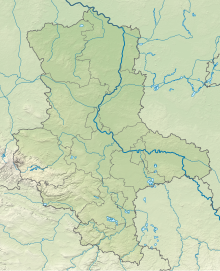Crassensee (nature reserve)
Coordinates: 51 ° 50 ′ 51 ″ N , 12 ° 30 ′ 27 ″ E
The Crassensee is a nature reserve in the Lutherstadt Wittenberg in the district of Wittenberg in Saxony-Anhalt .
The nature reserve with the registration number NSG 0100 is around 254 hectares . 168 hectares of the nature reserve are designated as a total reserve. The nature reserve is part of the FFH area “Dessau-Wörlitzer Elbauen” and the EU bird sanctuary “Middle Elbe including Steckby-Lödderitzer Forest” and is surrounded by the landscape protection areas “Elbetal - Crassensee” and “Middle Elbe”. The area has been under protection since the end of 2003 (date of regulation: December 15, 2003). It replaces the nature reserve of the same name, designated in 1967. The responsible lower nature conservation authority is the Wittenberg district.
The nature reserve, named after the lake of the same name , is located southwest of Lutherstadt Wittenberg and southeast of Coswig (Anhalt) in the Elbe River Landscape Biosphere Reserve . It is largely separated from the river dynamics by the Elbe dike and is only flooded when the Elbe floods. The nature reserve is characterized by an ash-elm- hardwood alluvial forest with a low proportion of field elm and crab apple . The alluvial forest is distinctive in its hornbeam formation at slightly higher locations . The alluvial forest has a high proportion of dead wood . The Crassensee, an oxbow lake of the Elbe, is embedded in the alluvial forest . The Crassensee is often surrounded by reeds made of reeds , broad and narrow-leaved cattails , plumes of water and calamus . The bank sedge and crab claw societies settle in silting zones, especially in the west of the lake . On the north bank of the Crassensee, the former sliding slope of the oxbow lake, there is an alluvial meadow with different degrees of use.
In the Crassensee there are spotted thousand-leaves , common hornwort , yellow pond rose , water hazel , pond lentil and common swimming fern . The nature reserve is the habitat of numerous bird species. The water and reed areas offer u. a. Mute swan , great crested grebe , pochard , coot , pond rail , kingfisher , reed bunting , pond warbler , great reed warbler and reed warbler a habitat. The lowland forests are the habitat of Red Kite , Black Kite , Honey Buzzard , Long-eared owl , tawny owl , black woodpecker , green woodpecker , great spotted woodpecker , middle spotted woodpecker , lesser spotted woodpecker , oriole and nightingale . Amphibians are by common frog , moor frog , pond frog , toad and newt represented. The waters in the nature reserve accommodate u. a. Bitterling , aland , ruff and moderlieschen . In addition, various invertebrates live here , including pond clams , European mud snails , ramshorn snails , water scorpions and yellow beetles . Dragonflies are z. B. represented by the green moss damsel , which has its largest occurrence here in Saxony-Anhalt, the eastern moss damsel and the brown mosaic damsel. The Crassensee is also the habitat of the Elbe beaver . Occasionally the otter could also be observed. The high proportion of dead wood in the alluvial forest makes the forest an important habitat for various wood-dwelling beetle species, including the stag beetle . The spring gill foot can be found in temporarily water-filled flood channels .
Web links
Individual evidence
- ↑ Order No. 3 on nature reserves of September 11, 1967 , GDR Law Gazette Part II No. 95 of October 19, 1967 (PDF, 27.7 kB). Retrieved April 13, 2018.
- ↑ Uta Langheinrich, Silke Dorow, Volker Lüderitz: Protection and maintenance strategies for floodplain surface waters of the "Middle Elbe" biosphere reserve , NF Hercynia, Volume 35, Martin Luther University Halle-Wittenberg 2002 ISSN 0018-0637 (PDF, 399 kB). Retrieved September 3, 2019.



